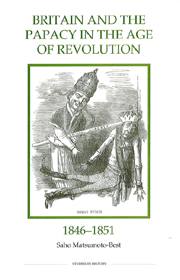Book contents
- Frontmatter
- Contents
- Dedication
- List of illustrations
- Acknowledgements
- Abbreviations
- Introduction
- 1 From 1815 to the election of Pius IX
- 2 The pope's liberal reforms, 1846–1847
- 3 The origins of the Minto mission
- 4 Britain and the 1848 revolution in Rome
- 5 Britain and the rise and fall of the Roman republic
- 6 The restoration of the Catholic hierarchy and anti-Catholicism in Britain
- Conclusion
- Bibliography
- Index
- Frontmatter
- Contents
- Dedication
- List of illustrations
- Acknowledgements
- Abbreviations
- Introduction
- 1 From 1815 to the election of Pius IX
- 2 The pope's liberal reforms, 1846–1847
- 3 The origins of the Minto mission
- 4 Britain and the 1848 revolution in Rome
- 5 Britain and the rise and fall of the Roman republic
- 6 The restoration of the Catholic hierarchy and anti-Catholicism in Britain
- Conclusion
- Bibliography
- Index
Summary
On 19 November 1847 the earl of Minto, the British lord privy seal and father-in-law of the prime minister, Lord John Russell, wrote from Rome to Sir George Hamilton, the British minister to Florence, about the policies of Pope Pius IX. He included in his letter a number of positive comments about Pius' attempts to reform the papal government and referred warmly to him as ‘the good Pope’. This favourable view was not expressed in isolation, for other politicians used similar language and the British press too joined in the chorus of acclaim. Even Punch, which was renowned for its radical sympathies and its sarcasm towards the pope, described Pius IX in the same period as the embodiment of ‘Rational Liberty’ who was giving the ‘Roman Punch’ to despotism.
It is surprising to find in the mid-nineteenth century this wave of governmental and public enthusiasm for the sovereign pontiff of the Roman Catholic Church, and indeed there cannot be many times since the Reformation when British politicians and the media have written in such complimentary terms about the occupant of the papal throne. The traditional attitude in Britain towards the papacy was in contrast very negative. The British government's normal view of the pope's role in European diplomacy and politics was that he acted as a supporter of the conservative powers and in particular of Austria. This support for the forces of reaction arose in part out of the need for Catholic unity, but in addition was necessary because of the nature of papal government and administration.
- Type
- Chapter
- Information
- Publisher: Boydell & BrewerPrint publication year: 2003



